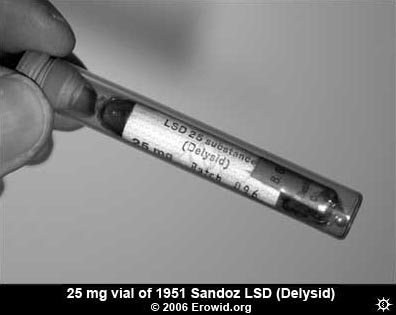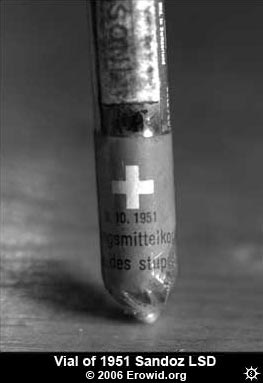Myth Debunking & Storage:
LSD Purity
Jun 2006
Citation: Erowid E, Erowid F. "LSD Purity". Erowid Extracts. Jun 2006;10:22-23.
 Whether or not there is any "real" d-LSD available on the underground market is a debate that recurs cyclically. Most informed people in the field dismiss the occasional flare-up of claims that those who have only had street acid after the 1970s have never had "pure acid". This claim is often accompanied by related claims that modern street acid is badly made, contaminated, degraded, or something other than LSD altogether. There are further speculations about whether even minute impurities could affect the receptor binding of LSD and therefore change the experience, or how LSD degrades over time, possibly converting active LSD into lumi-LSD, iso-LSD, or other less-well-known degradation products that might alter the effects of the material.
Whether or not there is any "real" d-LSD available on the underground market is a debate that recurs cyclically. Most informed people in the field dismiss the occasional flare-up of claims that those who have only had street acid after the 1970s have never had "pure acid". This claim is often accompanied by related claims that modern street acid is badly made, contaminated, degraded, or something other than LSD altogether. There are further speculations about whether even minute impurities could affect the receptor binding of LSD and therefore change the experience, or how LSD degrades over time, possibly converting active LSD into lumi-LSD, iso-LSD, or other less-well-known degradation products that might alter the effects of the material.It is our job to take such debates seriously and to try to add data to them wherever possible. Six years ago, we attempted to start an LSD Testing Project, but the complexity of the actual testing procedure coupled with a fear of the Drug Enforcement Administration by the labs licensed and capable of doing such testing meant that we were only able to get a single sample analyzed. Recently, an event occurred that provides some additional data in this slowly evolving debate.
An unopened, brown-glass vial of 1951 Sandoz LSD-25 (Delysid) was contributed to a gathering in celebration of Albert Hofmann's 100th birthday. The vial had been in the possession of a single person for the last 30+ years, stored casually, mostly in darkness. When opened, the powder was a very light brown-sugar to salmon color. One chemist described the fluffy, clumpy, sparkly crystalline powder as looking like "crushed needles". It was weighed and dissolved into four-ounce liquid doses containing between 100 and 110 micrograms each (± 10%).
Storage & Degradation
Although the vial was completely sealed, without cracks, one of the major questions was whether there would be significant loss of potency by degradation as a result of the 55 years that had passed since it was manufactured. After trying it, the predominant opinion among the more than 70 participants and observers was that there was no detectable loss in potency. This was the clearest result from the reported experiment: air-tight brown glass appears to be a very effective long-term storage method for LSD. After 55 years, stored at varying room temperatures, the LSD seemed to be fully potent.
Is Sandoz LSD Different?
The other major question on many people's minds seemed to be how Sandoz LSD would differ from the street acid they'd taken before. This was something a number of them considered, after the initial surprise over the fact that the material seemed not to have lost potency. We asked several participants to further describe their thoughts, by answering the query:
"Briefly describe your experience with LSD (number of times taken, how long ago first taken) and compare your experience of other sources of acid with the Sandoz material you tried. Was the Sandoz LSD different than street acid? Was it about the same? Share some of your thoughts about this."Some people appeared hesitant to answer whether they felt that the Sandoz LSD was qualitatively different from other acid they had taken. Several participants were moderately concerned that if they said the LSD seemed similar to other street acid, the observation could potentially sadden other participants or appear ungrateful to the extremely generous provider. There were raves about the unquestioned magic of the event, and the unique opportunity to try such an elusive and mythically sourced substance. However, the consensus among those to whom we spoke who had substantial experience with street acid was that the 55-year-old, apparently fully potent, Sandoz LSD was experientially indistinguishable from other acid they'd tried. Unfortunately, this subjective finding is unlikely to satisfy people who believe that street acid is impure and low quality. There could be two reasons why the effects of the Sandoz LSD were nearly identical to that of street LSD: good quality street acid could be as pure as Sandoz LSD, or the Sandoz LSD could have been impure or degraded. However, participants described feeling, both during and after the experience, that the quality was high and the potency undamaged; they considered the argument "street acid isn't really like pure LSD" to be settled.
Following are short comments from four people who tried the 1951 Sandoz LSD.

